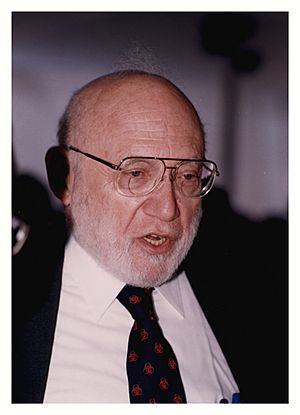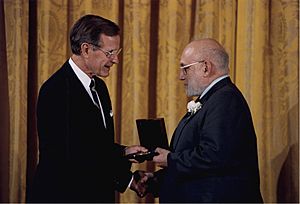Joshua Lederberg facts for kids
Quick facts for kids
Joshua Lederberg
|
|
|---|---|

Lederberg in New Delhi, India
|
|
| 5th President of Rockefeller University | |
| In office 1978–1990 |
|
| Preceded by | Frederick Seitz |
| Succeeded by | David Baltimore |
| Personal details | |
| Born | May 23, 1925 Montclair, New Jersey |
| Died | February 2, 2008 (aged 82) New York City |
| Nationality | American |
| Spouses | Esther Miriam Zimmer (1946–1966; divorced) Marguerite Stein Kirsch (1968–2008; 1 child, 1 stepchild) |
| Alma mater | Stuyvesant High School Columbia University Yale University |
| Known for | Neurospora crassa Bacterial conjugation Dendral Astrobiology Transduction |
| Awards | Nobel Prize in Physiology or Medicine (1958) National Medal of Science (1989) Presidential Medal of Freedom (2006) |
| Scientific career | |
| Fields | Microbiologist |
| Thesis | Genetic recombination in Escherichia coli (1947) |
| Doctoral advisor | Edward Tatum |
| Doctoral students | Norton Zinder |
Joshua Lederberg (May 23, 1925 – February 2, 2008) was an American scientist. He was a molecular biologist who studied tiny living things like bacteria. He also worked on artificial intelligence and the United States space program.
When he was just 33 years old, Joshua Lederberg won the 1958 Nobel Prize in Physiology or Medicine. He earned this prize for finding out that bacteria can "mate" and share their genes. This process is called bacterial conjugation. He shared the award with Edward Tatum and George Beadle, who also did important work in genetics.
Besides his amazing discoveries in biology, Lederberg also did a lot of research in artificial intelligence. This included helping with NASA's projects to look for life on Mars. He also worked on a chemistry computer program called Dendral.
Contents
Early Life and School Days
Joshua Lederberg was born in Montclair, New Jersey, in 1925. His family was Jewish. When he was a baby, they moved to Washington Heights, Manhattan. He had two younger brothers.
Lederberg was very smart. He finished Stuyvesant High School in New York City when he was only 15 years old, in 1941. After high school, he got to use a lab at the American Institute Science Laboratory. This was a program for talented young scientists.
In 1941, he started college at Columbia University. He studied zoology, which is the study of animals. He worked with a mentor named Francis J. Ryan. Together, they studied the genetics of a type of bread mold called Neurospora crassa.
During 1943, Lederberg worked at a hospital. He was a hospital corpsman, helping in the lab. He checked blood and stool samples from sailors for diseases like malaria. He earned his college degree in 1944.
Discoveries in Bacterial Genetics
Joshua Lederberg started studying medicine at Columbia University. But he also kept doing his own science experiments. He was inspired by Oswald Avery's discovery that DNA is very important for genetics.
Lederberg had a new idea. Most scientists thought bacteria just made exact copies of themselves, like clones. But Lederberg thought bacteria might share genetic information. He didn't make much progress at Columbia, so he wrote to Edward Tatum. Tatum was Ryan's mentor.
In 1946 and 1947, Lederberg took a break from medical school. He went to Yale University to work with Tatum. There, he discovered that bacteria can indeed share genes. He also helped map the E. coli chromosome. Because of this important work, he earned his Ph.D. from Yale University in 1947.
Joshua married Esther Miriam Zimmer on December 13, 1946. She was also a student of Edward Tatum.
Instead of finishing his medical degree, Lederberg decided to become a professor. He accepted a job at the University of Wisconsin–Madison. His wife, Esther Lederberg, joined him there. She earned her own doctorate in 1950.
In 1951, Joshua Lederberg and Norton Zinder made another big discovery. They showed that genetic material could be moved from one type of bacteria to another using viruses. This process is called transduction.
Later, in 1956, M. Laurance Morse, Esther Lederberg, and Joshua Lederberg found a special type of transduction. This explained how different kinds of bacteria could quickly become resistant to the same antibiotics.
While working in Joshua Lederberg's lab, Esther Lederberg also discovered something called the fertility factor F. This was very important for understanding how bacteria share genes. In 1956, both Joshua and Esther Lederberg received the Pasteur Medal for their great work in microbiology and genetics.
In 1957, Joshua Lederberg started the Department of Medical Genetics at the University of Wisconsin–Madison. He also visited other universities, like the University of California, Berkeley and the University of Melbourne. In 1957, he was chosen to be a member of the National Academy of Sciences.
After the Nobel Prize
In 1958, Joshua Lederberg won the Nobel Prize. After that, he moved to Stanford University. There, he started and led the Department of Genetics. He worked with Frank Macfarlane Burnet to study how viruses affect the body.
When the first satellite, Sputnik, was launched in 1957, Lederberg became worried. He thought space travel could bring tiny living things from space to Earth. These microbes could cause new diseases. He also worried that microbes from Earth might contaminate other planets. This would make it hard to find real alien life.
He wrote to the National Academy of Sciences about his concerns. He suggested that astronauts and equipment returning from space should be kept separate. He also said equipment should be cleaned very well before going into space. He worked with Carl Sagan to promote the study of exobiology, which is the search for life beyond Earth. This helped make biology a bigger part of NASA's work.
Lederberg was elected to the American Academy of Arts and Sciences in 1959. He also joined the American Philosophical Society in 1960.
In the 1960s, he worked with Edward Feigenbaum at Stanford. They developed a computer program called Dendral.
In 1978, he became the president of Rockefeller University. He held this position until 1990. After that, he became a professor there, focusing on molecular genetics and informatics. This showed how much he had worked in these areas.
Throughout his life, Lederberg was an important science advisor to the U.S. government. He was part of many committees that advised the President. In 1979, he joined the U.S. Defense Science Board. He also led President Jimmy Carter's Cancer Panel.
In 1989, he received the National Medal of Science for his contributions to science. In 1994, he led a group that looked into health problems from the Gulf War Syndrome.
In 1986, Lederberg went to the Soviet Union. He was investigating an anthrax bacteria outbreak that killed 66 people in the city of Sverdlovsk (now Yekaterinburg). At that time, he agreed with the Soviets that the outbreak came from animals. However, after the Soviet Union ended, new investigations in the 1990s showed the outbreak was caused by anthrax released from a nearby military lab. This was one of the deadliest lab leaks ever recorded.
Awards and Honors
- The Benjamin Franklin Medal for Distinguished Achievement in the Sciences from the American Philosophical Society, 2002.
- The Presidential Medal of Freedom, 2006.
- In 2012, a large crater on Mars was named Lederberg in his honor. It is 87 kilometers wide.
Family Life
Joshua Lederberg married fellow scientist Esther Miriam Zimmer in 1946. They later separated. In 1968, he married psychiatrist Marguerite Stein Kirsch. He was survived by Marguerite, their daughter Anne Lederberg, and his stepson David Kirsch.
See also
 In Spanish: Joshua Lederberg para niños
In Spanish: Joshua Lederberg para niños
- List of Jewish Nobel laureates
- LCF notation


